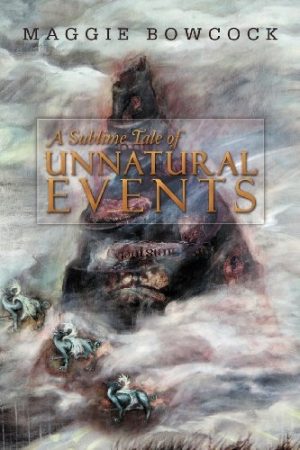A Sublime Tale of Unnatural Events
Ever since Plato wrote The Republic in ancient Greece, literature has carried the allegory tale from one era to the next. It’s a form most often used in religious fiction, because it allows the author to sermonize on religious values by telling a story. Maggie Bowcock’s A Sublime Tale of Unnatural Events is a Christian allegory, but it can be read as a straightforward fantasy as well.
Siblings Marjoram and Jack Maple are drawn away from their family one morning by the sunflowers in one of their mother’s paintings; the rest of the Maple clan later join them to hear why they’ve been led away from their home. The warrior guardians of their hometown, Wonder, are under assault, and the Maples have been chosen to lead the battle against the town’s takeover by dark forces. Along the way, Marjoram and Jack meet talking violets, the “unnatural” Thingamys, Dandelion (the source of life and all goodness), and others. They also have a few brushes with an ominous and shadowy enemy who seeks their destruction. In the “real world,” a parallel story unfolds concerning a bus explosion and the fate of a child named Betty who is severely injured in the blast.
The subjects of A Sublime Tale of Unnatural Events are certainly not common occurences, but despite the shadow of evil which invades the Maples’s peaceful lives, the story has, overall, an optimistic tone.
Bowcock is an artist and teacher. Her paintings make the story come to life, as does the nearly breathless pace of her writing, but punctuation errors detract somewhat from the reading experience. Bowcock’s prose has the feel of a children’s book, and the whimsicality of her nonhuman characters speak to both young and adult readers, though the book appears to be categorized as Young Adult. The text is informal without being folksy and good-hearted without being saccharine.
As do many legends and tales originating in cultural and/or religious histories, it presents its position in an easily comprehended format withouth being condescending. Bowcock has built a story that achieves the difficults tasks of simultaneously being an entertaining read and an often thought-provoking story of good vs. evil with a seldom-seen approach. As such, this book could be as valid a study subject for critical thinking courses as any Shakespearean play.
Reviewed by
J. G. Stinson
Disclosure: This article is not an endorsement, but a review. The publisher of this book provided free copies of the book and paid a small fee to have their book reviewed by a professional reviewer. Foreword Reviews and Clarion Reviews make no guarantee that the publisher will receive a positive review. Foreword Magazine, Inc. is disclosing this in accordance with the Federal Trade Commission’s 16 CFR, Part 255.

